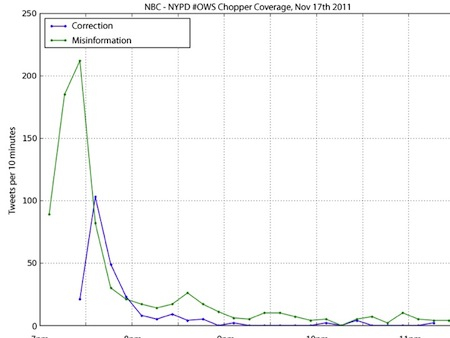The amplification effect of social media in real-time reporting
Are journalists making more mistakes than they used to, or does social media simply amplify the same mistakes to a much wider audience? Eric Mark Do reports from the latest CJF J-Talk on real-time reporting in a social media age.

From left: Kathy English and Mathew Ingram listen to Andy Carvin speak at a recent CJF J-Talk. Also on the panel was Esther Enkin (not pictured). Photo: Chris Young/CJF
Mistakes have always been made in journalism—especially in breaking situations. But perhaps more than ever before, social media allows for instant access to breaking stories while journalists are working on them, paving the way for those errors to be seen—and shared—by everyone.
NPR infamously reported (incorrectly) that U.S. Congresswoman Gabrielle Giffords had died after being shot in the head in January 2011. Andy Carvin, NPR's senior social media strategist, was the one who tweeted out that information, broadcasting to his followers what had been reported on the NPR newscast and published on its homepage.
“Within two minutes I started hearing from other reporters saying, 'We're at the hospital and we're hearing otherwise,'” Carvin said. He said it was a “cascade of failures” that happened, and that it was a reporting error, rather than an error made on Twitter. But Carvin’s tweeting of the at-the-time-unbeknownst mistake “amplified it in a way that got a lot of media attention afterward.”
Carvin joined Mathew Ingram, senior writer at GigaOM, and Esther Enkin, CBC ombudsman as panellists for Thursday's CJF J-Talk at the TMX Broadcast Centre titled “The Twitter Effect: Is journalism still able to get it right?” Toronto Star public editor Kathy English moderated a discussion with panellists about the contemporary challenges and ethical issues journalists face in their real-time reporting.
Journalism unveiled
Real-time journalism has opened up the process behind news gathering to the public for the first time. “I think we need to get used to the fact that information just doesn't flow the way it used to,” Ingram said. Now people can get news from social media rather than traditional gatekeepers, he said, such as evening newscasts and the morning newspaper.
Filtering information is key to online reporting, Carvin said.
For those of you who think I'm posting everything I'm finding, I'm actually sitting on about 75% of what I know b/c contradictions abound.
— Andy Carvin (@acarvin) December 14, 2012
Carvin sent out that tweet on December 14 while filtering information coming to him on the Newtown, Connecticut shooting. Many news organizations incorrectly circulated Ryan Lanza's photo as the suspect in the massacre, but the shooter was in fact his brother, Adam.
“When I tweeted things that were rumours, these were rumours that had just been reported by mainstream media,” Carvin said. He wasn't retweeting things that were only available through a random Twitter source. It's another example of how, like the Gabby Giffords shooting, it was journalists who got it wrong, not Twitter. (Carvin explained his process for reporting using social media as well. Check out this recent Reddit AMA with Carvin for more on that process.)
[node:ad]Enkin suggests reporters and news organizations should “hold back when the potential harm it can do is far greater than any accomplishment.”
What you don't know
Misinformation on Twitter spreads faster and wider than the subsequent correction (see the above graph courtesy of Craig Silverman's article on How journalists can do a better job of correcting errors on social media). Still, the panellists warned against deleting the error to avoid the appearance of a cover-up.
“You can't erase it and it's cached somewhere,” Enkin said. Someone probably already has a screenshot of it as well, Ingram added. (This is not a universally-shared view, as conversation on the #CJFjtalk hashtag brought up counter-arguments to this point)
To correct an error, admit to it first and then explain how the error came about, Carvin said. Transparency can aid in helping your followers understand how mistakes happen.
Crowd-sourcing information
While the panellists agree that the use of Twitter can amplify mistakes, it can also be used to verify information. During the media coverage of the Newtown shooting, Carvin did a search for tweets within the proximity of the school, looked for official government and emergency response unit accounts in the area — and looked through those accounts to see who they were following locally as well.
Carvin explained “So over the course of about 30 minutes I build up a profile of maybe 25-30 Twitter accounts that will be more likely to know something than otherwise.”
People who are within the vicinity of the news can be valuable sources, Carvin said. During the Libyan revolution, a lot of video footage was coming in online, but news editors chose not to air it because locations were unverified. Carvin retweeted the videos and asked his Twitter followers to analyze them. They identified accents of voices and recognized various landmarks that helped him verify information. Carvin’s followers also provided him with a Google Maps image comparison.
“That's an example of what I mean by an open-sourced newsroom,” Carvin said. “[It is] tapping into the collective knowledge of my Twitter followers and allowing them to geek out in researching these things.”
This transparency in admitting to what you don't know is better than not addressing an issue and, as demonstrated, can be beneficial when gathering information.
“There are people out there that know more about the thing that you are tweeting about or writing about than you do,” Ingram said. “You need to use all the tools you possibly can to reach those people so they can tell you, 'This is right,' or 'This is wrong,’ because you don't know.”





